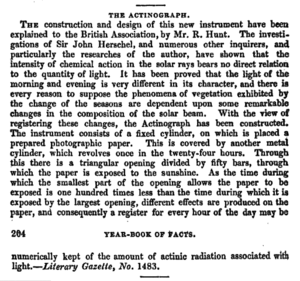
Actinograph
Encyclopedia


Photographic film
Photographic film is a sheet of plastic coated with an emulsion containing light-sensitive silver halide salts with variable crystal sizes that determine the sensitivity, contrast and resolution of the film...
. That is, it measures the actinic or chemical intensity of light, as opposed to radiometric
Radiometry
In optics, radiometry is a set of techniques for measuring electromagnetic radiation, including visible light. Radiometric techniques characterize the distribution of the radiation's power in space, as opposed to photometric techniques, which characterize the light's interaction with the human eye...
or photometric
Photometry (optics)
Photometry is the science of the measurement of light, in terms of its perceived brightness to the human eye. It is distinct from radiometry, which is the science of measurement of radiant energy in terms of absolute power; rather, in photometry, the radiant power at each wavelength is weighted by...
amount of light.
The earliest actinographs were 24-hour recording devices, using a rotating cylinder of photographic paper exposed through a wedged-shaped slit to record a graph of actinic light during the period of a day; hence the graph suffix in actinograph. Such devices were developed and described by Robert Hunt
Robert Hunt (scientist)
Robert Hunt , a scientist and antiquarian, was born at Devonport, Plymouth, in the United Kingdom. He was involved in statistical, mineralogical and other studies. He died in London on 17 October 1887.-Early life:...
, secretrary of the Royal Cornwall Polytechnic Society
Royal Cornwall Polytechnic Society
The Royal Cornwall Polytechnic Society is an educational, cultural and scientific charity, based in Falmouth, Cornwall, England, United Kingdom. The Society exists to promote innovation in the arts and sciences...
in 1845, as an improvement on T. B. Jordan's 1839 Heliograph.
In 1888, Ferdinand Hurter
Ferdinand Hurter
Ferdinand Hurter was a Swiss industrial chemist who settled in England. He also carried out research into photography.-Early life:...
and Vero Charles Driffield
Vero Charles Driffield
Vero Charles Driffield was a chemical engineer who also became involved in photographic research.Driffield was educated at Liverpool Collegiate and Sandbach Grammar School. He also attended a private school in Southport where he came into contact with a Swiss master called Dr Knecht...
patented a device for estimating the actinic power of sunlight and for computing exposure times and apertures for cameras, based on the plate speed
Film speed
Film speed is the measure of a photographic film's sensitivity to light, determined by sensitometry and measured on various numerical scales, the most recent being the ISO system....
, time of day, time of year, and latitude. These were slide rule
Slide rule
The slide rule, also known colloquially as a slipstick, is a mechanical analog computer. The slide rule is used primarily for multiplication and division, and also for functions such as roots, logarithms and trigonometry, but is not normally used for addition or subtraction.Slide rules come in a...
s, not measuring instruments, and did not produce a graph, but Hurter and Driffield adopted the same name for it.
In 1911, Arthur William Clayden M.A. (Fellow of the Royal Meteorological Society and Principal of the Royal Albert Memorial University College of Exeter) developed a version of an actinograph for meteorologists, to observe and record the change of radiation.

